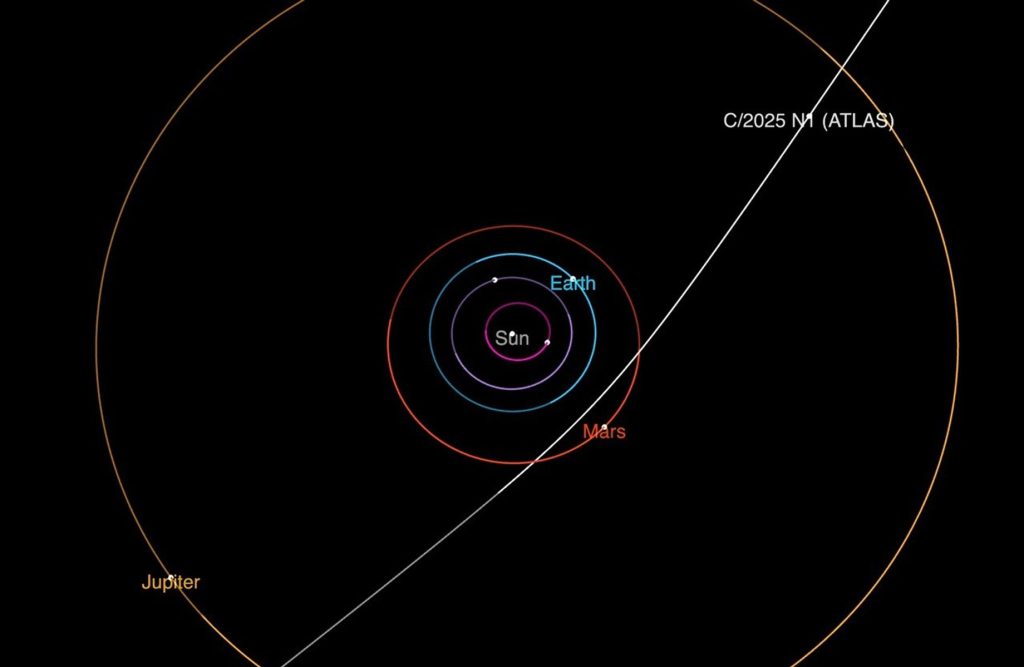
Astronomers using the ATLAS telescope in Chile detected a faint, fast-moving object on July 1 that was later confirmed to be traveling on a hyperbolic path through the solar system. The object, now designated 3I/ATLAS, is the third known interstellar body ever discovered, following ‘Oumuamua in 2017 and Borisov in 2019.
Initial analysis showed 3I/ATLAS is not gravitationally bound to the Sun and originated from outside the solar system. Within days of the discovery, observatories worldwide began coordinated follow-up campaigns. NASA confirmed the finding and initiated multi-mission observations involving the Neil Gehrels Swift Observatory, the Hubble Space Telescope, and the James Webb Space Telescope, along with several ground-based facilities.
Early data from the Swift mission indicated the presence of hydroxyl molecules, a byproduct created when sunlight breaks apart water vapor. This provided the first indication the comet was releasing water while still about 3.5 astronomical units (about 525 million kilometers) from the Sun, beyond the orbit of Mars.
At that distance, surface temperatures are typically too cold for water ice to easily sublimate. The detection suggests 3I/ATLAS may be venting from exposed or unusually volatile ice, or possibly from icy grains suspended in its surrounding coma.

Observations estimate a water loss rate of approximately 40 kilograms per second, a level of activity not often seen so far from the Sun. Additional measurements from the Gemini South telescope in Chile and the James Webb Space Telescope have confirmed a growing dust coma and a developing tail. The comet’s nucleus is believed to be only a few kilometers wide.
Archived imagery from the Zwicky Transient Facility in California later revealed the object was faintly visible in late June, before its formal discovery, suggesting early activity at even greater distances.
As the object moved closer, the European Space Agency assigned its Mars Express and ExoMars Trace Gas Orbiter to conduct coordinated imaging when 3I/ATLAS passed Mars in early October at a distance of around 30 million kilometers.
Each interstellar object provides a limited opportunity to study material that formed around another star. Spectroscopic data from Webb and Hubble are being used to measure the ratio of volatiles such as carbon dioxide and water, which could help compare 3I/ATLAS to comets native to the solar system.
Scientists are also examining the dust composition to determine how it responds to solar radiation and whether it contains complex organics.
The early detection of water-related activity at large distances is prompting further analysis of cometary thermal models. If the data are confirmed, it could suggest sublimation begins under colder conditions than previously understood or that fine-grained ice behaves differently when exposed to sunlight in space.
According to astronomers, 3I/ATLAS is being studied from multiple perspectives, not only to characterize its composition but to refine methods for identifying and tracking future interstellar visitors. Improvements in survey telescopes, such as the Vera C. Rubin Observatory in Chile, are expected to increase the number of similar detections in coming years.
Because interstellar comets move at high velocity and follow open trajectories, observation windows are limited. 3I/ATLAS is traveling at approximately 60 kilometers per second relative to the Sun and will make its closest approach – about 1.4 astronomical units, or 210 million kilometers – on October 30 before continuing back into interstellar space.
While data collection will continue after its closest approach to the Sun, brightness is expected to decline as it moves away. Researchers are using this short opportunity to capture spectra, measure dust release, and model its composition before it fades from view.
The discovery of 3I/ATLAS adds to the small but growing category of interstellar bodies that have passed through the solar system. Each new detection provides data on material formed under different stellar conditions and contributes to a broader understanding of how planetary systems evolve.
FTC: We use income earning auto affiliate links. More.




Comments